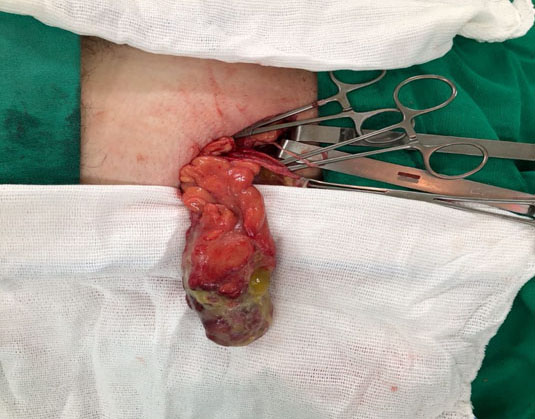 |
Case Report
Amyand's hernia associated with acute appendicitis
1 Medical Sciences Course, Health Sciences School, Faculdade Ceres (FACERES), São José do Rio Preto, SP, Brazil
2 Neurosurgeon, Member of the Brazilian Society of Neurosurgery, Santa Mônica Hospital, Goiânia, GO, Brazil
3 Medical Sciences Course, Health Sciences School, Metropolitan University of Santos, Santos, SP, Brazil
4 Neurosurgeon, PhD in Neurosurgery, Member of the Brazilian Society of Neurosurgery, Professor at Santa Mônica Hospital, Goiânia, GO, Brazil
Address correspondence to:
Pedro Nogarotto Cembraneli
Avenida AnÃsio Haddad nº 6751, São José do Rio Preto, SP,
Brazil
Message to Corresponding Author
Article ID: 100078Z06PC2020
Access full text article on other devices

Access PDF of article on other devices

How to cite this article
Cembraneli PN, Cavalcante JBF, Cavalcante RBF, Ambrogi G, Cavalcante JES. Amyand's hernia associated with acute appendicitis. Case Rep Int 2020;9:100078Z06PC2020.ABSTRACT
Introduction: Amyand’s hernia (AH), a rare form of inguinal hernia, is characterized by finding the cecal appendix within the hernial sac. It is observed in 0.4–0.6% of inguinal hernias and complications such as acute appendicitis or perforated appendicitis can occur in 0.1% of the cases. The diagnosis is most often performed intraoperatively and its classification and management depend on the degree of appendix involvement.
Case Report: A 53-year-old male patient presenting with right iliac fossa pain for two days associated with a mass in the right inguinal region. Physical examination revealed an irreducible right inguinal hernia, leading to the diagnosis of incarcerated inguinal hernia. Surgical treatment was proposed and performed. It evidenced the presence of the cecal appendix within the hernial sac with clear signs of inflammation (type II of the Losanoff and Basson classification). The cecal appendix was reduced, an appendectomy was performed via McBurney incision, and the right inguinal abdominal wall was repaired with no need for prosthetic mesh.
Conclusion: Although AH is a rare condition, it should be considered among the differential diagnoses in cases of pain in the iliac fossa, inguinal swelling, and signs of infection.
Keywords: Acute abdomen, Acute appendicitis, Amyand’s hernia, Inguinal hernia
INTRODUCTION
Amyand’s hernia is an inguinal hernia in which the vermiform appendix, whether inflamed or not, is located within the hernial sac. It was first diagnosed in an 11-year-old boy and described by Claudius Amyand in 1735 as an incarcerated inguinal hernia containing the perforated appendix. The patient underwent ligation of the hernial sac and appendectomy simultaneously [1],[2].
Although AH includes two frequent clinical entities, it only accounts for approximately 0.4–0.6% of all inguinal hernias, and is even more rare (0.1%) in cases of acute appendicitis [3],[4],[5],[6]. Preoperative diagnosis of AH is rare and, in most cases, this condition is only diagnosed during urgent surgical interventions [7]. Here we report the case of a 53-year-old male patient intraoperatively diagnosed with AH associated with acute appendicitis.
CASE REPORT
A 53-year-old male patient was admitted to the emergency service complaining of pain in the right iliac fossa for two days. He reported the presence of a mass in the same region for 20 days, at first painless. However, two days before, he started feeling pain, which worsened and was associated with nausea and vomiting, with no signs of obstruction. Physical examination revealed an irreducible right inguinal hernia, leading to the diagnosis of incarcerated inguinal hernia. Therefore, immediate surgical treatment was proposed. In the intraoperative period, a hernial sac containing the cecal appendix with clear signs of inflammation, categorized as type II of the Losanoff and Basson classification, i.e. acute appendicitis within an inguinal hernia, with no abdominal sepsis. The cecal appendix was reduced, the appendectomy was performed via McBurney incision (Figure 1 and Figure 2), and the right inguinal abdominal wall was repaired with no need for prosthetic mesh. The diagnosis of acute appendicitis was confirmed by pathological examination. The patient had a good evolution and was discharged on the third postoperative day.
DISCUSSION
Amyand’s hernia is more common during childhood because inguinal hernias are often caused by patency of the processus vaginalis. About 2% of appendectomies are due to AH in the pediatric population. It predominantly occurs in males and most cases are located on the right side. The exact mechanism of AH is not fully understood [8],[9].
Preoperative diagnosis of AH is a challenge given the considerable variation of symptoms that patients present with [8]. Additionally, its clinical signs and symptoms are normally indistinct and this entity lacks typical radiological diagnostic characteristics [9]. Hence, it is rare to make a clinical diagnosis of AH preoperatively. In general, it is detected incidentally intraoperatively, after opening the hernial sac [10]. Patients often undergo emergency operation with a presumptive diagnosis of either incarcerated or strangulated inguinal hernia [11], inasmuch as AH may mimic a strangulated inguinal hernia, testicular torsion, epididymo-orchitis, or inguinal lymphadenitis [12]. Some of the most common complaints are sudden onset of epigastric or periumbilical pain, tenderness in the right lower quadrant, tender irreducible mass in the inguinal or inguinoscrotal region [12], acute onset of right groin pain [13], anorexia, nausea, and vomiting [4]. Physical examination shows a painful and irreversible protuberance in the groin area [11],[12],[13].
Most surgeons do not recommend imaging exams such as ultrasound and computed tomography (CT) for preoperative diagnosis, due to lack of typical radiological features [8] and also because inguinal hernia repair is mandatory and immediate therapeutic intervention is indicated [5],[10],[14]. Nonetheless, preoperative diagnosis can be incidentally made using CT with oral contrast in patients with suspicion of appendicitis [14].
Losanoff and Basson proposed a classification for AH, establishing different types of surgical management for each of them. In type I, AH is a normal appendix within an inguinal hernia. The recommended approach is hernia reduction with mesh repair, and appendectomy if the patient is young. Type II is characterized by acute appendicitis within an inguinal hernia, but with no signs of peritonitis. Appendectomy through the hernia and primary endogenous repair of hernia without mesh are mostly performed in these cases. Type III AH is acute appendicitis within an inguinal hernia complicated by abdominal wall or peritoneal sepsis. It is mandatory to perform appendectomy through laparotomy and primary repair of hernia without using mesh. In type IV, acute appendicitis within an inguinal hernia is associated with other related or unrelated abdominal pathologies. These cases require the same management adopted for types I–III AH, and it is necessary to investigate and/or treat the second pathology as appropriate [2],[3],[9],[13],[14],[15],[16].
If surgical treatment is delayed, a natural history of acute appendicitis may include perforation and abscess formation (types III and IV of Losanoff and Basson). Therefore, prompt treatment contributes to a better prognosis and rapid postoperative recovery [5].
CONCLUSION
Despite being a rare condition and primarily found incidentally during surgery, AH should be among the differential diagnoses in patients presenting with acute pain in the iliac fossa region, irreducible right inguinal hernia, and signs of infection. Hence, it is of paramount importance that surgeons and residents become familiar with incarcerated appendixes within hernias. The management of AH varies according to its classification, but it is always surgical and when associated with acute appendicitis, it has absolute indication of appendectomy and hernia repair without using mesh, according to the classification proposed by Losanoff and Basson.
REFERENCE
1.
Amyand C. VIII. Of an inguinal rupture, with a pin in the appendix coeci, incrusted with stone; and some observations on wounds in the guts. Philos Trans 1735;39(443):329–42. [CrossRef]

2.
Mewa Kinoo S, Aboobakar MR, Sigh B. Amyand’s hernia: A serendipitous diagnosis. Case Rep Surg 2013;2013:125095. [CrossRef]
[Pubmed]

3.
Kose E, Sisik A, Hasbahceci M. Mesh inguinal hernia repair and appendectomy in the treatment of Amyand’s hernia with non-inflamed appendices. Surg Res Pract 2017;2017:7696385. [CrossRef]
[Pubmed]

4.
da Fonseca-Neto OC, Lucena RC, Lacerda CM. Amyand’s hernia: Inguinal hernia with acute appendicitis. [Article in Portuguese]. Arq Bras Cir Dig 2014;27(4):309–10. [CrossRef]
[Pubmed]

5.
Michalinos A, Moris D, Vernadakis S. Amyand’s hernia: A review. Am J Surg 2014;207(6):989–95. [CrossRef]
[Pubmed]

6.
Sharma H, Gupta A, Shekhawat NS, Memon B, Memon MA. Amyand’s hernia: A report of 18 consecutive patients over a 15-year period. Hernia 2007;11(1):31–5. [CrossRef]
[Pubmed]

7.
D'Alia C, Lo Schiavo MG, Tonante A, et al. Amyand’s hernia: Case report and review of the literature. Hernia 2003;7(2):89–91. [CrossRef]
[Pubmed]

8.
Dange A, Gireboinwad S. Case report: A rare case of Amyand’s hernia presenting in a 3-year-old male child. Indian J Surg 2013;75(4):332–3. [CrossRef]
[Pubmed]

9.
Ivanschuk G, Cesmebasi A, Sorenson EP, Blaak C, Loukas M, Tubbs SR. Amyand’s hernia: A review. Med Sci Monit 2014;20:140–6. [CrossRef]
[Pubmed]

10.
Gupta S, Sharma R, Kaushik R. Left sided Amyand’s hernia. Singapore Med J 2005;46(8):424–5.
[Pubmed]

11.
Cankorkmaz L, Ozer H, Guney C, Atalar MH, Arslan MS, Koyluoglu G. Amyand’s hernia in the children: A single center experience. Surgery 2010;147(1):140–3. [CrossRef]
[Pubmed]

12.
Okur MH, Arslan MS, Zeytun H, Otcu S. Amyand’s hernia complicated with acute appendicitis: A case report and literature review. Ped Urol Case Rep 2015;2(4):7–12. [CrossRef]

13.
Quartey B, Ugochukwu O, Kuehn R, Ospina K. Incarcerated recurrent Amyand’s hernia. J Emerg Trauma Shock 2012;5(4):344–6. [CrossRef]
[Pubmed]

14.
Green J, Gutwein LG. Amyand’s hernia: A rare inguinal hernia. J Surg Case Rep 2013;2013(9). pii: rjt043. [CrossRef]
[Pubmed]

15.
Singal R, Mittal A, Gupta A, Gupta S, Sahu P, Sekhon MS. An incarcerated appendix: Report of three cases and a review of the literature. Hernia 2012;16(1):91–7. [CrossRef]
[Pubmed]

SUPPORTING INFORMATION
Author Contributions
Pedro Nogarotto Cembraneli - Conception of the work, Design of the work, Acquisition of data, Analysis of data, Drafting the work, Revising the work critically for important intellectual content, Final approval of the version to be published, Agree to be accountable for all aspects of the work in ensuring that questions related to the accuracy or integrity of any part of the work are appropriately investigated and resolved.
Julia Brasileiro de Faria Cavalcante - Conception of the work, Design of the work, Acquisition of data, Analysis of data, Drafting the work, Revising the work critically for important intellectual content, Final approval of the version to be published, Agree to be accountable for all aspects of the work in ensuring that questions related to the accuracy or integrity of any part of the work are appropriately investigated and resolved.
Renata Brasileiro de Faria Cavalcante - Conception of the work, Design of the work, Acquisition of data, Analysis of data, Drafting the work, Revising the work critically for important intellectual content, Final approval of the version to be published, Agree to be accountable for all aspects of the work in ensuring that questions related to the accuracy or integrity of any part of the work are appropriately investigated and resolved.
Gabriel Ambrogi - Conception of the work, Design of the work, Acquisition of data, Drafting the work, Final approval of the version to be published, Agree to be accountable for all aspects of the work in ensuring that questions related to the accuracy or integrity of any part of the work are appropriately investigated and resolved.
José Edison da Silva Cavalcante - Conception of the work, Design of the work, Drafting the work, Revising the work critically for important intellectual content, Final approval of the version to be published, Agree to be accountable for all aspects of the work in ensuring that questions related to the accuracy or integrity of any part of the work are appropriately investigated and resolved.
Guarantor of SubmissionThe corresponding author is the guarantor of submission.
Source of SupportNone
Consent StatementWritten informed consent was obtained from the patient for publication of this article.
Data AvailabilityAll relevant data are within the paper and its Supporting Information files.
Conflict of InterestAuthors declare no conflict of interest.
Copyright© 2020 Pedro Nogarotto Cembraneli et al. This article is distributed under the terms of Creative Commons Attribution License which permits unrestricted use, distribution and reproduction in any medium provided the original author(s) and original publisher are properly credited. Please see the copyright policy on the journal website for more information.







